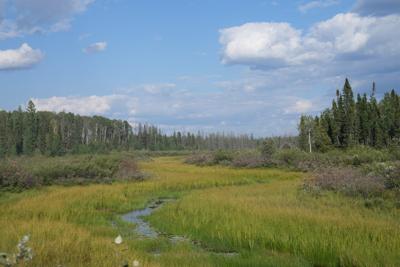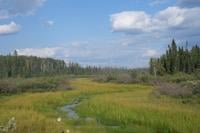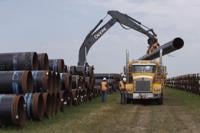TORONTO - A proposed road to the mineral-rich Ring of Fire in northern Ontario will bring economic prosperity to Webequie First Nation, though it may endanger caribou in the region, a newly released assessment finds.
Webequie First Nation is leading an environmental and impact assessment of the Webequie Supply Road that would connect to mining exploration activities in the Ring of Fire.
That road will connect to two other proposed roads that would link the remote First Nation to the provincial highway system hundreds of kilometres south.
"This is a critical milestone for our people and our project," Chief Cornelius Wabasse said in a statement.
"We are proud of this important work and the respectful approach taken to get it done. We are also grateful for all those who support Webequie's journey to self-determination, economic self-reliance and a better future for our people."
The work and subsequent draft report were done under the province's Environmental Assessment Act and the federal Impact Assessment Act. The report is thousands of pages long and has been shared with 22 other First Nations in northern Ontario for a 60-day review period, which will be followed by a final report filed to both levels of government.
The assessment examined how the natural and socioeconomic environments, Indigenous land use and traditional knowledge of the area would be affected by building the supply road.
The 107-kilometre, two-lane road will take four to six years to complete once construction begins and will need six bridges and 25 culverts to cross various bodies of water, the report said.
The proposed road will run northwest-southeast for 51 kilometres from the First Nation's airport to the next segment that will run 56 kilometres east-west to McFaulds Lake and the Eagle's Nest mineral exploration site.聽
The proposed mine is owned by Wyloo, an 聽Australian mining company with its 春色直播 operations based in Toronto.聽
The road is expected to last 75 years, after which major refurbishments will be needed.
The projected construction costs to the province are $663 million, though it's unclear yet who will own the road and who will be allowed to use it. The First Nation said those details will come in future negotiations with Ontario.
"Our vision for the Webequie Supply Road is an economic development road that creates real opportunities for our young people and future generations to drive to work and back," Wabasse said.
"This project offers possibilities to provide skills training for our youth, create new jobs and business opportunities, and strengthen Webequie's economic future while remaining deeply connected to our land and traditions."
The report assumes construction would start in the winter of 2028 and be complete by the summer of 2032, though a start date has yet to be announced.
The report comes amid great debate about mining in northern Ontario.聽
Premier Doug Ford's government recently passed Bill 5 into law with the aim to speed up development of mining and other projects. The new legislation has been met with outrage and resistance from First Nations.
The government has given itself the power to suspend provincial and municipal laws through the creation of so-called "special economic zones" for projects it chooses.
The province intends to designate the Ring of Fire the first such zone, though it has said it will not do so until it consults with First Nations in the region. Details about how that would actually work are sparse.
The Webequie Supply Road is expected to have a significantly positive effect on the First Nation's economy during construction and beyond, the assessment found.聽
"Community members have emphasized the issues of unemployment and the lack of growth and learning opportunities," the report said.聽
"With the anticipated road access connectivity from the project, potential economic growth is expected, leading to job opportunities for community members, allowing them to work closer to home."
The province has pledged some $70 million to help train Indigenous workers for jobs in development and mining. Wyloo also trains its workers who are conducting mineral exploration at the Eagle's Nest site.聽
Other mining and forestry opportunities are likely to arise once the road is built, the report found.
By and large, the threats to animals and plants from road construction are not considered significant, except for a few species at risk that include the boreal caribou.聽
There are about 5,000 caribou left in the province, the vast majority of them in northern Ontario. Webequie First Nation and the proposed road are within that animal's range.
The species is considered threatened in Ontario, which means it could become endangered if protective steps are not taken.聽
Construction and operation of the road is "expected to provide predators such as wolves increased access to the caribou, particularly where the road traverses natural movement corridors," the report said.
"Overall, caribou injury or death due to changes to predator-prey dynamics from the project is considered a significant adverse effect based on current vulnerability of the population," the report found.
The construction of the road will also change the caribou's habitat, it said.
Road construction will also affect another threatened species, wolverines, the report found. There are only two known mature female wolverines in the entire study area. One den is within 400 metres of the proposed road site and "will likely lose function as denning habitat due to the indirect effects of clearing activities."
About half of the proposed road is in the James Bay Lowlands, which is dominated by peatlands, a weak material to build a road upon. Engineers have decided a "floating road" is the best option, done by "carefully loading materials over peat, allowing time for it to consolidate and increase in strength."
While building the road will have an effect on all parts of the environment, much of that will be negligible with proper mitigation efforts, the report found.
For example, the report said fish and their habitat will not be significantly affected as crews build the six bridges and 25 culverts because construction barriers will be temporary. 聽
The First Nation is also concerned the road will bring more alcohol and illicit drugs to the community, and said it will try to limit access to outsiders during construction as much as possible.
"Webequie First Nation remains committed to an Indigenous-led approach that supports responsible development while upholding our environmental stewardship responsibilities," its chief said.聽
This report by 春色直播was first published June 16, 2025.








































